 Kent Coast Sea Fishing Compendium |
Beach Casting |
"The Badminton Library: Modern Sea Fishing" (1895) John Bickerdyke at pages 193 & 194
From Land and Pier
When I first practised this kind of fishing I used to think the great point was to cast as far as possible, long casting being a weakness common to most young fishermen, who always think the fish lie mainly under the opposite bank of the river or the other side of the Atlantic. But I had a very wholesome lesson one evening. I had gone down to the shore after dinner, taking my rod and a few mussels, and fished for a good hour without getting a solitary bite. I was just giving up in despair when three little urchins, the eldest of whom could not have toddled on this earth for more than ten years, came trotting down the beach. One of them had a penny ball of string; another a hook tied on gut; while the third produced three mussels. Twine-makers do not give us much string for a penny; so the line was very short, and after a stone had been fixed to the end of it and the hook tied on and baited, the most the little fellows could do was to cast their bait a yard or two beyond the point where small waves were breaking on the shore.
I do not know if my face bore a pitying smile, but I certainly felt that way, and was searching my pockets to see if I had not a piece of string which could be attached to the youngsters' line, when, behold, the eldest raised a scream of delight and hauled in a codling of about two pounds. I was distinctly humiliated, but was not too proud to profit by the lads' experience; so I quickly reeled in my line and made a fresh cast, placing the paternoster just over the line of little breakers. There the fish were in thousands, I should say, for hardly had the bait reached the bottom before I had a bite. I continued pulling out fish one after the other until I had about a dozen and a half, when I had to return to the town. I think the boys caught two or three more; but, being thankful for the lesson they had unconsciously given me, I presented them with most of my codlings.
After that experience, whenever I found the fish were not feeding at the usual distance, I would wind in a few yards of line; then wait a minute or two, and if no bite came, wind in a few more yards and wait again; and so on until the paternoster was brought right up to the shore. This movement of the paternoster was, in fact, a thorough searching of the fishing ground, and it had a secondary advantage, for the slight motion given to the baits often made the fish bite when they were not very well on the feed.
Standard Cast
"Angles on Sea Angling" (1963) Captain S. Norton-Bracy at pages 7, 8 & 9
Fishing from Pier and Beach
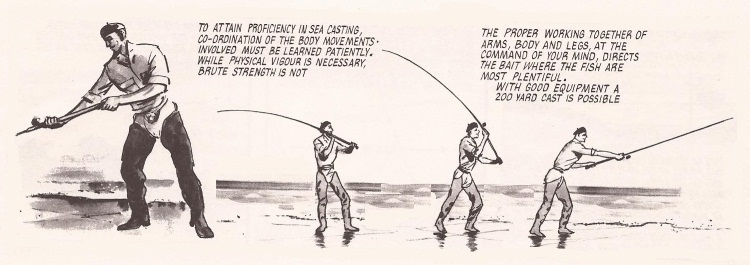
Skill in casting can help to improve your 'luck' when there are other anglers about.
When you are fishing from a pier, or from a beach where there are a lot of other anglers, the farther out you can cast the more likely you are to catch fish. The continual bump of weights hitting the bottom, close in to the pier, and the jangling of paternoster booms, are enough to scare away any worthwhile fish. So try to out-cast all the other anglers.
There is no doubt that most beach or pier fishermen could, with the right equipment, increase their casting distance by 25 per cent. What you need is better stance, and this calls for correctly-balanced tackle. With multiplyer or fixed-spool reels, anyone can reach a minimum of 100 yards. You will find heavy rods tiring: the ideal is a glass-fibre rod of 12 feet to 13 feet. The line should be 16lb to 27lb breaking-strain nylon. A 4oz weight is heavy enough to take the line out without causing it to over-run.
When you get a "bird's-nest", the reel is revolving faster than the line is running out and the result is a tangle. How does it happen ? The most frequent mistake when casting is to use too much effort. A smooth 180-degree cast is enough to get your weight to its maximum distance without the worry of an over-run. Make sure that the line is free from knots and the spool is filled to capacity. Keep these rules - and you will still occasionally face the "bird's-nest" nightmare. But not so often.
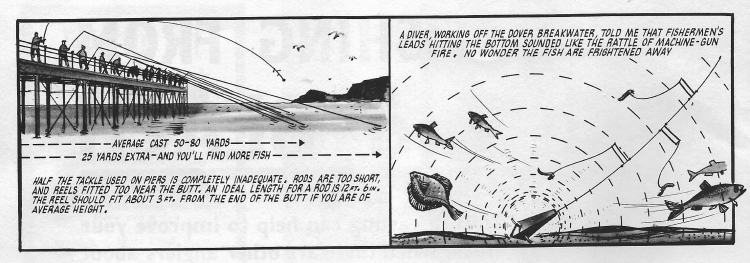
The standard casting method is used with a beachcaster rod and multiplier reel.
For the beginner, or for casting short distances into the "fish zone", a straight over-the-head cast is the most suitable casting method. Ensure before casting that:
- the line is running freely through the rod eyes
- when using a fixed spool reel, the bail arm is open.
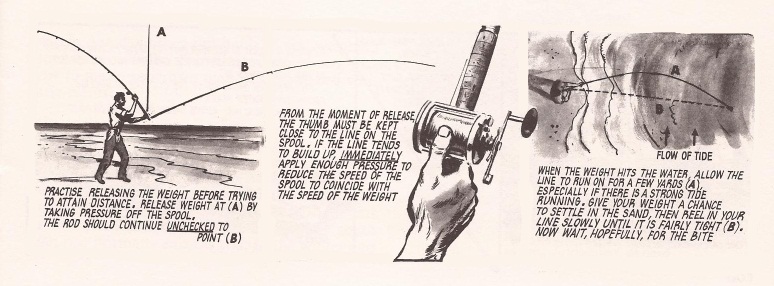
Off-the-Ground Cast
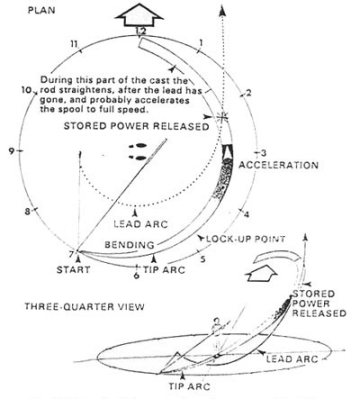
- Start off facing the direction you want the sinker to travel, twist your body 180° putting your weight on the back leg.
- Put a small bend in the back leg and put the rod about 60° further around. The rod should be 240° from the direction you want to cast.
- Lay the sinker on the ground 90° to the direction of the rod. The distance of the sinker from the rod tip wants to be at least half the total rod length. More length will give more power but makes the cast harder.
- You are now ready for the off-ground cast. Your spool should be free; you should be coiled, sinking slightly on your back foot.
- Now uncoil, start with your head and bring the arms around last, keep the tip of the rod rising slowly. This will compress the rod.
- If you are right handed think about pulling your left elbow up and through. Your weight should now be on both feet and you left hand above head height.
- When your left arm reaches full extension pull it down and punch the right hand up, lifting the rod tip up and putting your weight into the cast by putting weight onto your front foot.
- Release the line when it feels right, the rod should be 45° and now pointing towards the sinker.
With practice you will perfect the off-the-ground cast - practice in a large field with just a sinker.
If possible get someone to video your cast so you can see how balanced you look during the off-ground cast.
"Approach to Angling in Fresh and Sea-Water" (1950) E. Marshall-Hardy and Lieut. N. Vaughan Olver, R.N.V.S.R. at pages 196 to 199
Section IV: Sea Fishing from Jetty, Pier or Shore
Chapter III
Fishing on a Sandy Shore
The Tackles
… Oddly enough long casting is seldom an advantage when fishing from the shore or a pier. But you will find that anglers are very competitive in this matter. A sees B make a prodigious cast and immediately attempts to emulate him - don't do it! You are just as likely to catch a fish near to, as far from the pier. And when fishing from the shore, if you can cast your bait just beyond the breakers it is usually all that is necessary; because the fish are foraging in the disturbed water. Sheep which seem always to regard the pasture just beyond the barbed wire as preferable, lose a lot of wool; and anglers who try to cast too far lose a lot of tackle.
When you have learned to cast a double-handed-side-swing, practice the overhead.

Very often when fishing from a pier you will find not only that you are one of a serried rank of anglers, but that you have an audience, composed all too often of people who do not realise that fish-hooks in the pants are painful and may be dangerous, not to speak of the disadvantage of being clubbed with a four ounce lead weight. The overhead cast shown in Fig. 127 is the most compact and useful when pier-fishing. Here again the principles of control are identical with those for any other cast. The illustration will I hope, make the movements clear.
… Having cast, tighten up your line on the lead and holding the rod comfortably under your arm (with the point up keep the line taut), hook your finger under the line between the reel and the first ring. This will enable you to detect delicate bites.
The bites of various species are typical and varied; small fiat fish give a tremulous nibble, school-bass two quick tugs, and so on. But it is not within the scope of this book to go deeply into these differences. You must fish and learn from experience. The best method is, "when in doubt, strike".
If you feel a suspicious movement of the line which passes over your finger, raise the rod point smartly stepping back a pace simultaneously, and if the fish is hooked you know what to do, be it a dab or a large bass.
From your reading of this section you may be under the mistaken impression that one has only to chose a fishing mark with knowledge and intelligence, to guarantee a catch. Of course this is not true, indeed angling would lose much of its fascination if this were possible.
Sea-angling can be a slow game, so when the fish are not feeding the rod-rest can be used. There is usually a convenient support on a pier or a jetty. A bell is clipped to the rod, just below the top ring, and this will sound when a bite jerks the rod top. I advise you, however, to hold the rod as soon as fish appear to be interested in your bait, for you will be able to detect many small nibbles which are not strong enough to agitate the bell. You will also be ready to strike and keep in contact with the fish, which is most important.
From half flow to ebb tide, is the time to fish - after that you can "pack up".
"Salt-Water Angling" (1956) Michael Kennedy at pages 103 to 108 & 116 to 118
Spinning
Casting with a Multiplying Reel
In casting with the outfit described, the line is first reeled up until the trace (or anti-kink) is just clear of the end ring of the rod (make sure the swivel is not reeled back through the end ring). The check of the reel is then clicked off, the spool is prevented from revolving by pressure of the thumb on the line spool, and all is set for the actual cast (Fig. II, 6).
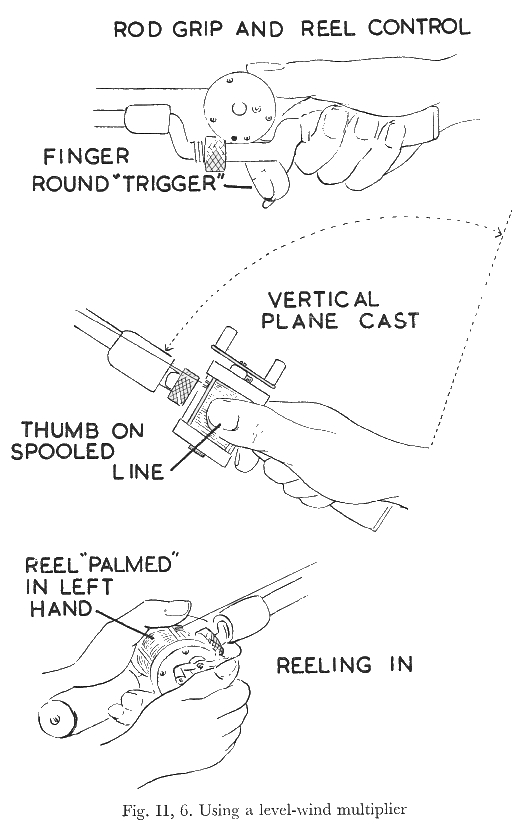
This may be made in a number of ways. Where all that is wanted is to sling the bait out a good distance, more or less straight ahead (or when it is necessary to under-cut an adverse wind), the angler faces in the direction he wants to throw, with his left foot in advance (the cast, as with a centre-pin reel, being made partly across the body). The rod is then swung sharply back to about five o'clock (target - twelve o'clock); and, at the limit of the backward swing of the bait, the rod is immediately flicked forwards again, through a rising plane inclined about 45 degrees from the horizontal, pitching the bait up and out. The elbow should be kept close to the side; and the forward flick of the rod should be short, swift, and snappy, and timed to synchronize with the kick of the rod, reacting to the pull of the swung-back bait, which momentarily flexes it. Just as the bait is shot up and away, the reel is released; but after allowing it a moment's complete freedom to start spinning, it is gently braked, by light pressure of the thumb on the spooled line and/or the side of the thumb against the inner face of the line-spool. (This is the thumbing previously referred to, and it is a tricky business until you get the knack of it.) The angler will find that, with practice, intermittent thumbing makes for longer casts than continuous thumb-pressure - a touch on the spool an instant after it has been jerked in fast revolution; two or three light touches during the flight of the bait; and a gentle application of pressure as the bait begins to lose speed, are all that is required to prevent over-running.
Where accuracy rather than distance is the chief consideration, the rod can be flicked backwards and forwards through a vertical plane; the rod being, as it were, cut forward in a direct line for the spot where it is desired to put the bait. The bait should, however, be thrown high - not at the target, but well up into the air, in a curve that will drop it on the target. The amount of force put into the cast should be proportionate to the distance to be cast, though a touch on the line-spool will slow down the flight of the bait if it seems likely to overshoot the mark.
… In casting, do not hold the rod too tightly - the cast is made partly with the forearm but largely with the wrist; and too cramped a grip on the rod will hamper wrist action. Note, the manner in which rod is held in Fig. II, 6, in making an overhead cast - the trigger is pointing away from you, the reel towards you, so that the side of the rod is its leading edge. In making a side cast, the trigger should point towards the ground (not towards the target) so that, again, the side of the rod is its leading edge. This makes for easier and more effective wrist action in casting.
Whatever method of casting is employed, the point of the rod should follow-through the flight of the lure: and unless the cast is made with the left hand, the rod is shifted from right hand to left before winding in. When fishing very shallow water with a sinking lure, and it is desired to prevent its touching the bottom (e.g. if there are weeds on the bottom, which it may pick up), the reel should be checked the instant the lure touches the water; and the rod should be drawn back over the shoulder (right or left shoulder) before it is switched from right hand to left - the change of hands being effected as rapidly as possible, without lowering the rod; and the wind-in being commenced the instant the fingers of the right hand establish contact with the reel handles. The rod can be lowered after a few turns of the reel handle, once the bait is moving through the water, and the danger of its sinking to the bottom is past.
During the retrieve, the rod point should be kept low - unless it becomes necessary to skim the bait over weeds, or a just-submerged rock, when the rod should be raised, and (unless the bait is a diving plug) the retrieve should be speeded up; the bait, if possible, being skimmed along the surface, until it is in the clear again.
The shortness of the rod makes it less easy to keep the bait from snagging the weeds fringing the shore at the end of the retrieve, than when a double-handed spinning rod is used. However, the following trick will keep the bait from getting snagged - as the bait approaches the weeds, draw it towards the surface, speed up the retrieve and, just as the bait breaks the surface, jerk it clear of the water, continuing to wind in as it travels through the air, so that it ends up swinging from the rod tip. This is much less difficult to do than it sounds ! Don't try to jerk the bait out of the water before it reaches the surface - it may momentarily resist your jerk, then slap up in your face.
General Remarks
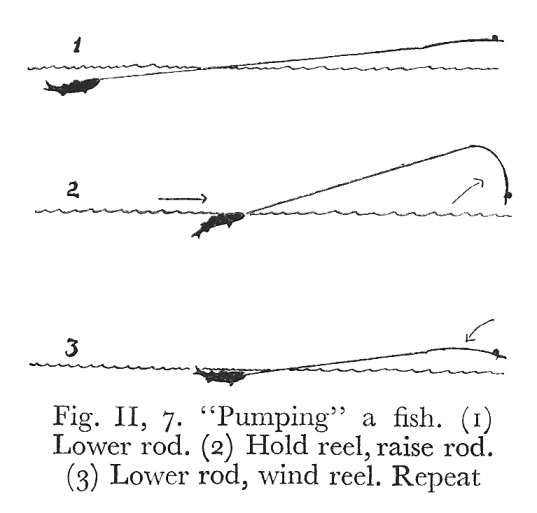
Multiplying reel tackle is best suited to surface and near-surface spinning, but the use of wobbling spoons or deep-running plugs makes it possible to fish levels down to about six to ten feet below the surface. A heavy spoon can be fished sink-and-draw much deeper than this, but a heavy lure may put too much strain on a light rod; which, too, may not be powerful enough to set the hooks in a fish which seizes the lure deep down in the water. A heavy spoon can, of course, be fished deep if a powerful bait-casting rod is used.
… Accordingly, recovery of line against a fish (always assuming, of course, that the fish has been played out sufficiently to submit to being pulled in) should be effected, not by attempting to grind away with the reel, but by pumping. In pumping a fish (Fig II, 7) the rod is lowered and the line wound taut; then, while the reel is prevented from revolving, the rod is raised, pulling the fish towards the angler; whereupon the rod is lowered again, and the resultant slack line is wound in. The line should not actually be allowed to go slack; rather, in effect, the rod should be wound down until it is pointing towards the fish. In short, the procedure is, alternately, to hold the reel and raise the rod; and to lower the rod and wind the reel - hence the description pumping. The rod, instead of being raised, may be drawn back parallel with the water, when pulling the fish closer.
This pumping technique is also employed at times with fixed-spool reels; and it may be necessary at times, to resort to it even when using a single-action reel, e.g. where a big fish has to be brought to the surface from a considerable depth.
In lowering the rod (or pointing it towards the fish) to slacken the line, the angler should be on the alert for sudden resistance on the part of the fish - and be ready to release the reel handle if the fish begins to plunge, or attempts to dash away. For when the rod is pointing towards the fish, the full strain of any tugs or jerks comes on the line, without the intervention of the rod, which ordinarily acts as a shock-absorber.
Spinning with a Fixed-Spool Reel
Though the invention of the fixed-spool reel dates back to 1905 when Illingworth patented the original model of the reel which bears his name, it was not until the years between the wars that spinning with fixed-spool reels attained anything like its present popularity.
The multiplier, with its lightweight, narrow-diameter spool, represents an attempt to reduce to the minimum the inertia that constitutes a major problem in spinning with any form of revolving-drum reel. The fixed-spool reel represents an altogether more radical attempt to deal with the problem; in this type of reel there is no inertia to overcome in making a cast, no reel-momentum to cope with, for the simple reason that the line-spool remains stationary during the cast.
The Fixed-Spool Reel
The elimination of the inertia problem makes spinning with a fixed-spool reel easier to learn, and more fool-proof (up to a point!), than spinning with any form of revolving-drum reel …
Casting with a Fixed-Spoon Reel
The most comfortable way to hold a thread-line rod (although it may not feel at all comfortable at first) is with the first and second fingers in front of the saddle-pillar of the reel, the third and fourth fingers behind it, and the thumb extended along the top of the hand-grasp (Fig II, 9).
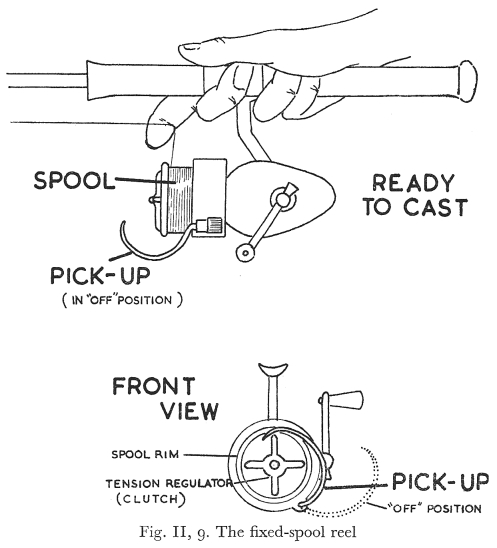
… the angler faces the direction he wishes to cast, with his left foot in advance. The line having first been reeled up until the trace (or anti-kink) is just clear of the end ring of the rod, the line is slipped off the pick-up, and held in the crook of the forefinger (Fig II, 9); and the pick-up is then clicked into the off position. The rod, held about waist level and nearly horizontal, is then swung back through a small arc, and at the limit of the back swing of the bait, the bait is thrown forwards and slightly upwards by a quick flick of the wrist. The elbow should remain bent, and close to the side, and the rod should be pivoted back and flicked forward from the wrist rather than from the elbow.
When greater distance is required, the rod can be swung back and flicked forward through a greater arc; the forearm, as well as the wrist, can be called into play; more force can be put into the cast; and the bait can be thrown higher into the air - though its trajectory need never be so high and curving as that of a bait cast with a revolving-drum reel.
Where pin-point accuracy is desired, an overhead cast - in which the rod is cut forward in a vertical plane, directly at the target - can be employed … As the bait shoots forward, the angler allows the line to slip from his forefinger, and spiral off the reel; and he follows through the flight of the bait with the point of the rod. As the bait falls into the water, he brings his left hand forward, catches the reel handle, and turns it; when the pick-up locks into position, and gathers up the line.
It is best to pick up the line as soon as the bait touches the water, while there is still a pull on the line, as the pick-up sometimes misses the line if it goes slack. If the bait is seen to be going too far - into danger - a turn of the reel handle automatically curtails its flight, and a twitch of the rod jerks it back to safety while it is still in mid-air. It is here that the advantage of the left-hand-wind reel becomes obvious. Another advantage of the left-hand-wind reel is that the retrieve can be commenced even before the bait touches the water, so that the bait is spinning as it enters the sea.
"The Complete Sea Angler" (1957) Richard Arnold at page 45
Another factor comes into play whilst the line is shooting through the rod rings. The reel, running freely, begins to revolve at a greater speed than the line leaving it. Unless, therefore, some check is put on it, it will "over-run". An over-run means that the leaded line, which starts off with a sudden increase in velocity, gradually loses its speed, whereas the reel is gaining in speed. The net result is a frightful tangle in the line. It may happen … that the tangled line lodges firmly in a rod ring. The leaded line is brought to a full stop with a terrific jerk and breaks. The hook, lead, paternoster or spinner then continues a wild, free, parabolic flight and is lost …
To prevent the reel from over-running, the angler must check or brake the reel at the proper moment, and this is done by gradually putting pressure on the reel rim by the forefinger of the lower hand.
The proper moment to apply pressure on the reel is when the lead is about midway on its course. The pressure should be increased just before the lead hits the water so that the reel is stopped.
Immediately the beginner has made his cast he should put the check on the reel. Wait for a moment or two and then commence to recover the line.
The Daily Express, Saturday 23 February 1963 at page 9
Going Fishing
It's the Long Shot that Bags the Big'uns
By Clive Gammon
Thick-eared – that is how I once heard sea-fishing described. Crude, in other words requiring little skill. Certainly of no interest to the man who practised the delicate arts of roach or trout fishing.
In the days when heavy plaited flax lines, massive lead weights and poker-stiff rods were standard equipment for sea fishermen, there was some truth in this, but sea-fishing stopped being thick-eared with the arrival of modern synthetics.
Nylon lines and light hollow-glass rods have transformed the sport. There is nothing thick-eared about using a fly rod to driftline for black bream over a Sussex coast reef, or spinning a tide rip for big bass or fighting it out with a 50 lb. tope on a 15 lb. breaking strain line.
It is the beach fisherman who has benefited most from the new tackle developments. By using a wide spool multiplier and a long surfcasting rod, he can punch out a bait 100 yards or more when storm beach bass are feeding behind the furthest breaker, for instance, or when a long cast has to be made from a steep shingle beach to reach the food-bearing sand.
There is a technique to be acquired, of course, and no one has done more to develop it than Leslie Moncrieff, the Surrey fisherman whose remarkable catches of cod at Dungeness caused so much stir among sea anglers.
Like earlier angling innovators, however, Moncrieff has had his critics. There were fishermen who flatly refused to believe it was possible to cast as far as he cast. Others claimed that long-casting meant over-casting, that fish were being missed because they were feeding inshore of the bait.
The first criticism he silenced by touring angling clubs and demonstrating his methods, showing that 100-yard-plus casts were within the scope of the average, angler with the right equipment.
His own catches were sufficient to answer the other criticism. Moreover, Moncrieff had never said that long-casting was desirable in all situations.
I am sure that the beach fisherman is under a severe handicap if he has not mastered long-casting technique. Sometimes, Indeed, even a yard or two of extra distance can make all the difference between a blank day and a good bag.
Daily Express, Saturday 19th March 1966 at page 14
Fishing
New British Reel a Winner
Clive Gammon
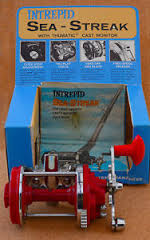
I went bass fishing this week - at least a month too early by local reckoning. But two things lured me out. A brilliant burst of spring sunshine that turned our normally grey Atlantic to a picture postcard of the Costa del Sol. And the opportunity to test a new British reel - the first ever surf casting multiplier to be produced here.
Actually, we invented the multiplier way back in the eighteenth century, but we just didn't bother to develop it. Which has meant, up to now, that if a British angler wanted a first-class surf casting reel he would have to buy an imported model - probably American.
Export
Now, I can happily report, this is no longer true. International casting champion Barrie Welham has introduced the Sea-Streak and it is going to make a revolutionary impact on British sea anglers and even, export-wise, an unprecedented dent on the huge U.S. Home market.
Most salt water experts would agree that the multiplier is the best reel to use in surf casting. The average angler on the other hand, has been slow to follow their example, simply because using a multiplier demands a somewhat long and difficult apprenticeship.
Infuriating tangles and birds' nests are all too common in the early stages, and many quietly give up and return to the less efficient but easier to use fixed spool reel.
The Sea-Streak is going to change all that. It incorporates the first really efficient cast monitor mechanism I've come across, so that the spool automatically slows down as the weight begins to drop at the end of the cast.
Suffered
There have been other governing devices before, of course, but this is the first that prevents over-runs, yet does not cut down drastically on casting distance. My bass fishing, I must confess, suffered as I found excuses to reel in and try yet another cast. But there weren't any bass about anyway, and soon I'd abandoned all pretence of fishing, and settled down to a one-man casting tournament on the beach.
For the technically minded, I had loaded the Sea-Streak with an 18 lb. line with a 20 ft. 35 lb. "collar." Rod was an 11 ft. 20 oz. beach caster, and the lead a 3oz. Torpedo.
The recorded distances averaged out at a little under 130 yards, which made it clear to me that the cast monitor of the Sea-Streak was having little or no limiting effect on distance.
I was able to make a controlled experiment as well. Along came a beach angler who had never cast with a multiplier before. His first effort clocked under 90 yards !
Editor's Note: The Intrepid Sea Streak (made in England by K. P. Morritt Limited) was a very popular beach casting multiplier. However the bearings made a dreadfull noise on casting and it was affectionally known as the Sea Screach. The Sea Streak was a large, heavy duty sea reel with the following features:
- Camatic Level Wind which helps the angler cast further
- friction free bale arm roller
- ambidextrous for left or right hand use
- corrosion resistant materials throughout
- Thumatic cast monitor
- 4 way line control which includes the famous TRUE-PLAY allowing the rod to be safely rested
- fibre glass reinforced spool which ran on stainless steel ball bearings
- Sure Lock clamp
"The Sea Angler Afloat and Ashore" (1965) Desmond Brennan at pages xvi, 161 & 162
Introduction
The importance of food is obvious yet it is so often seemingly overlooked by anglers. Frequently I have watched anglers spend fishless hours at the end of a long pier fishing in deep water while the fish they sought were feeding closer to the shore. Either the anglers found the end of the pier more convenient to fish from or else suffered from the delusion that fish can only be caught in deep water. The same applies to shore anglers who insist on casting as far as they possibly can when a short cast of 20 yards or less would put them amongst the fish. It leads one to think that some anglers are more concerned with the distance they can cast than with catching fish. Remember, fish will be where their food is and not where you think they should be or where it is convenient for you to fish. Fish are not concerned with your convenience but with their own stomachs. So find the food and you will find the fish.
The Fishes of the Sea
Fishing on surf beaches normally calls for surf casting tackle, as conditions of surf, depth or sweep of tide may call for long casts or the use of heavy sinkers to hold the bottom. The distance one must cast varies considerably and depends on many factors. Food swept out of the sand by the action of the surf is sucked seawards by the undertow until its progress is halted by the opposing force of the oncoming waves, when it is deposited on the bottom. This usually takes place just behind the last "breaker" and it is here you can expect the bass to be feeding. They will be found just behind the breaker in a line parallel to the shore and you must get your bait out to them. On very shallow beaches at low water or in heavy surf the waves may be breaking a considerable distance out and very long casts are essential if you are to get among the fish. When the tide is well up on the beach near high water and there is good depth close in, the line of breakers may only be 20 to 30 yards away or less and short casts are then the answer.
Do not get into the habit of making long casts just for the sake of doing so because you will find that your bait is often far beyond where the fish are feeding. Granted there are occasions when you must be able to cast 100 yards or more to reach the fish but these conditions are more the exception than the rule and normally with a nice surf running (three nice breakers are ideal) casts of 50 to 80 yards are all that is necessary. On some beaches where the surf breaks a long way out you will find a "table" of water. Here the bass will be inside the line of breakers and you must search the water to find out where they are feeding. These conditions seem to be ideal for flounders, which can make a perfect nuisance of themselves to anglers fishing for bass.
In calm conditions with light surf or near high water in moderate surf, bass will feed right in on the shore and I have seen them run right up a beach and down again on a wave. In these conditions, and also at night when bass come much closer to the shore, it is very easy to overcast as the fish may be no more than 10 to 20 yards out.
The Daily Express, Saturday 15 July 1967 at page 8
Fishing by Clive Gammon
Out of My Class
It Takes a Big Throw to Catch the Way-Out Cod
Nobody at Hawick, Scotland, is likely to miss seeing Leslie Moncrieff when he carries his rod and line to the British casting championships of 1967.
He is 6ft. 5in. tall, known to angling magazines as the "Gentle Giant".
But it is not the man's height that makes Moncrieff a hero-figure in British beach-fishing – it is the fantastic distance he can cast a line.
"Let's dispel one illusion right away", said Moncrieff as we drove to the coast for some practice. "I do NOT cast 160 yards by using my height and weight. They give me only a small advantage. The secret of the big throw is simple - the Big Action. You can do it. Anybody can do it."
Campaign
"Wait a minute" I said. "The only angling I've done is to hang a worm in a stream from a bamboo cane …" "All the better", said Moncrieff. "You haven't picked up any bad casting habits."
We arrived at Hythe, Kent, where Moncrieff first started his campaign to put the Big Action into British beach casting. He has made thousands of converts since.
He set up his 11ft 9in. glass fibre rod and attached a 5 oz weight to the line. He cast.
"Wheee-eee-eee … " The nylon spun off the reel with a thin, drawn scream, and the weight plopped into the sea at about 140 yards away.
Two or three anglers strolled up, for a cast of 140 yards is an eye-catching event. It is twice the distance achieved by the average beach-fisherman.
"That must be a Moncrieff casting-rod" said one. "I am Moncrieff" said Moncrieff.
There was a suitable reaction. "Do it again" the Master was urged. "Show how".
Soaring
Moncrieff enjoys showing how. His next cast sent the line only 100 yards. But he made that on his knees.
"In this position I am exactly 4ft tall", he grinned. "I hope that proves I don't rely on my height to make a big throw".
Moncrieff caught his first fish on Folkestone pier when he was six years old. He is now 52. He never did cast in the traditional English style, which he calls "chuck-it and chance-it".
The Big Action came naturally. But 13 years as a research engineer – he now owns a drapery business – enabled him to analyse and work out the fine mechanics.
"ALL the weight on the right foot" he instructed me. "This is called the 'lay-back' so I want you to reach way, way back with your rod. You come out and over at two o'clock … so."
"Your shoulder is turning behind the rod and it is one smooth acceleration – then punch! Punch, punch that line soaring up into the sky!"
The shrill song of my own line ended abruptly as the nylon line 'birds'-nested' out of the reel. Yes, I had done it wrong.
"But I get the idea" I said. "The ordinary caster shapes up to it like a man standing in a bus queue – no stance."
Tangles
"Right, he just pokes his line into the water" said Moncrieff. "Whereas we use the maximum arc, don't we? We punch the line out like a javelin-thrower, only we don't have to work so hard."
I worked hard. In several fouled attempts I managed one 60-yard cast. I unpicked some interesting tangles of nylon too.
The mighty Moncrieff, strangely enough, holds no titles for casting, though he constantly beats the British record of 156 yards. At Hawick today he is taking part in his first casting competition. It may well be his last.
"I am an angler, not a tournament caster," he said. "I just want to prove, once and finally, that my method works. Then I can get back to what it's all about – catching fish."
Moncrieff has the enviable habit of standing on a beach and catching half his own weight in cod before it is time to open the lunch-box. "Did you bring any bait?" I said.
"Bait?" said Moncrieff. "You don't think you are going fishing, do you ?"
Practice
After a week or two of dry-land practice, he said, I might be getting into the swing of the Big Action. I shouldn't rush things. "Tell you what, come back in September with the Action" said Moncrieff, "then I'll show you how to try it on a fish".
"Sea Fishing for Beginners" (1970) Maurice Wiggin at pages 20, 22, 34 & 35
Chapter I
First Things First
But there came upon the scene, not so long ago, the truly scientific intelligence in the shape of a friend of mine named Leslie Moncrieff. Mr Moncrieff is a member of a small band of wizards, who foregather in a sort of coven in Hertfordshire, where they have cooked up many profoundly brilliant ideas which have changed the face of fishing … But it is Leslie Moncrieff, leading spirit of the Moncrieff Rod Development Company, who has turned his attention to the salt water, and he who has effected a single-handed revolution in beach casting.
This huge strong man first came into fame, or notoriety, at the famous cod ground of Dungeness, where his prowess in hurling a lure far out into the 'Dustbin', where cod congregate at that point where sand meets shingle, first irritated and then awed his fellow anglers, who were consistently falling short. Leslie did not owe his startling success entirely to his physique, formidable though that is. Using his brains, he had divined the secret of the reverse-taper or 'spring butt' casting rod which makes it easy.
… Now, with the Moncrieff-designed Longbow (and other rods, of which more later, at the appropriate points) they have come strongly into the sea fishing scene. I don't honestly know a better beach casting rod than the Longbow; if I did I would tell you.
Chapter II
The Tools of the Trade
… I fancy that the craze for distance has resulted in some rods being longer than the average angler can really use to full advantage. We aren't all monsters (physically speaking, I hasten to say) like Leslie Moncrieff. Though actually his own rods are a moderate length, at 11 ft 3 in up. This seems about right to me: I am 5 ft 11 in and enfeebled by a long perhaps not entirely healthy life among the ink pots.

Fig. 6 shows you the steps in a good cast, made with a proper rod and a multiplier. Having fitted up your rod, fixed the reel in its seat securely, and threaded the line through the rod rings, not missing any more than you can help, you then tie on the terminal tackle. This … consists roughly of your weight, swivel or swivels, hook and bait …
Now wind in until you have merely a few feet of line hanging from the rod tip - four feet is plenty, three will do. Stand with the feet a comfortable distance apart, at about right angles to the sea, with your left foot extended in the direction which your cast is to take. The left hand grips the butt at its lowest point, the right hand grips the reel seating, with the right thumb on the spool of the reel (assuming, of course, that you are a right-hander). Turn the body away from the sea and rest the weight on the ground behind you. When you are ready, with the thumb firmly on the spool, bring the body round strongly. Left hand pulls in on the butt, right hand pushes out. This puts a big bend in the rod. At the moment when the rod is about to straighten, in the direction of your cast, release the thumb pressure - but keep the thumb just kissing the spool while the weight flies out over the water. The thumb comes down firmly again as the weight hits the water.
There are, of course, many subtle variations on this basic cast. Some anglers lay back farther; some turn the body through a greater arc, some through a lesser. Some intrepid performers don't rest the weight on the ground but hang it from the rod tip, swinging it round in an aerial circle rather like an Olympic hammer thrower getting up speed. You will soon find which style suits you best. Whichever it is, it is the style for you.
"Competition Sea Angling" (1970) Bruce McMillen at pages 49 & 50
4. Methods
Casting
Quite one of the most controversial subjects in angling is casting. Let us therefore examine casting techniques and their effect upon competitive angling.
Long casting from piers, rocks and beaches undoubtedly has its merits and, conversely, it may quite rightly be said also to have its demerits. Firstly, one must face the fact that some anglers are so proud of their casting prowess that, in order to impress, they often cast such unnecessarily long distances that their terminal tackle enters the water at a point well beyond where the fish happen to be feeding at that particular time.
Under such circumstances it becomes evident that these casting fanatics fail utterly and completely to satisfy the primary object of their angling which is, of course, to catch fish. On the other hand, there are conditions where the ability to cast a great distance proves to be a vital asset. Undoubtedly, these are occasions when the fish are feeding some distance out and it is under these circumstances that the long-distance caster really comes into his own. For this reason alone it may be said that he possesses a fishing ability over those of his fellows competitors who are less competent at casting.
The conditions under which exceptionally long-distance casting is essential to success are, however, very few and far between. For this reason, providing Mr. Average Caster is one who applies an intelligent knowledge to his technique he will invariably hold his own at most events.
Here are some points concerning the ability to long cast and its relation to competitive angling:
Merits
- It enables the competitor to reach out to fish feeding at a distance from the shore, pier or rocks.
- In crowded events, it enables the competitor to place his baited terminal tackle beyond the barrier of constantly descending sinkers cast by less proficient contestants.
- If the tide is flowing towards the pier, etc., fish swimming with the tide will reach the long-caster's bait before that of other competitors.
- Long casting can assist the angler to clear rocks and heavy weed beds, etc.
Demerits
- The long-distance caster can sometimes prove to be a positive menace in crowded beach or pier events, particularly so if his terminal tackle lands beyond that of other competitors and is carried by currents across their lines and tackle. This can happen no matter what type of sinker is used.
- When fishing a pier event and the tide is flowing away from the ranks of competitors, those baits lying nearest to the pier will be the first to be seen by fish travelling downtide. Those who have cast the furthest will then be at a disadvantage.
- In some areas, masses of floating weed drift across and foul the lines and eventually carry the baited tackle right inshore. Normally under such conditions, the further one casts the more weed one is likely to gather on the line, sometimes to the extent of making fishing virtually impossible. This is very noticeable where strong tidal currents run parallel to the beach. This is not mere hearsay, but has been a personal experience on more than one occasion.
- Modern reel lines are invariably nylon monofilament, a substance which has a high degree of stretch. Glass fibre rods are very resilient and the combined effects of both tend to absorb a firm strike made against a taking fish, particularly when the fish happens to be some distance away from the rod tip. In this respect the long-distance caster has less chance of driving the hook in with force. Various practical experiments in this connection have proved to me that lines of braided terylene, used in conjunction with a stiff action built-cane rod take far more bass than tubular glass rods of similar length, used in conjunction with nylon monofilament which, incidentally, has four times the elasticity of terylene.
So, there are arguments for and against long-distance casting.
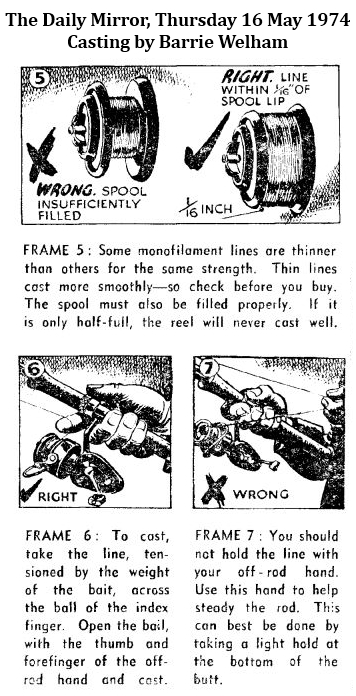
"Fisherman's Handbook" The Marshall Cavendish Volume 1, Part 6 (1977) John Holden at pages 141 to 143
Tackle
Beachcasting Rods
The first shore fishing tackle was a simple arrangement of hook, line and sinker either lowered into the sea from rocks and piers, or cast out with the aid of a pole. The line and pole are still used in parts of East Anglia and West of Ireland. Roy Cook, a highly successful Suffolk beach fisherman, has updated the equipment to incorporate a line drum and winder which eliminate the laying out and retrieving of line by hand. He casts sinker and baits up to 140 yards, and the tackle is sensitive and powerful. For both bite detection and fighting big fish, however, the simple handline is superior to rods and reels.
At the turn of the century, shore fishing became a sport rather than the means of catching fish for the table. Rods were huge Barma canes or redundant salmon rods cut down at the tip. The emphasis was on strength. Crane-like designs continued to be employed until the late 1950s, although appearance and construction became more sophisticated. Even so, the first glass-fibre rods retained the traditional weight and clumsiness that branded sea fishing with its cloth cap image.
Glass-fibre rods
Leslie Moncrieff's 'Springheel' rod heralded a new era of shore fishing, and was the first production beach casting rod to exploit the the advantages of glass-fibre. It became a huge success, not only because of the introduction of glass-fibre but because for the first time the average angler could expect to cast 100 yards. Moncrieff himself demonstrated that the rod, used with his 'Layback' casting style, would hurl 4 oz and 6 oz sinkers well beyond 150 yards - greatly in excess of contemporary tournament records. The effects on beach fishing were shattering – overnight the sport became highly technical and socially accepted.
The beach casting tournaments became a battle-ground for designers and manufacturers. A second breakthrough arrived in the form of ABU's 484, a stiff-butted rod with a very fast action that boosted casting range beyond the magical 200-yard barrier. Since then tournament distances have increased marginally to the current record cast of 222 yards, using a 6 oz weight and a multiplier reel. Perhaps it is not a coincidence that as casters and rod-makers strive for extra performance, many shore fishing rods have become excellent casting implements but second-rate fishing tools. It was hoped that carbon-fibre would redress the balance by giving maximum casting performance to light, well-balanced rods that were still perfect for everyday fishing. So far the results are less than satisfactory, and the cost, at 10 times that of ordinary glass-fibre, is prohibitive. Nevertheless, the longer-term future of carbon-fibre is very bright indeed.
Rod construction
The construction of beach casting rods follows a general pattern. A glass-fibre tube, the blank, is moulded around a cylindrical rod or mandrel, hardened, removed from the mandrel and ground smooth. It is cut and spigotted or ferruled to give two or three interlocking sections. The butt is sheathed in cork, sleeved with a plastic shrink tube or fitted with grips. Traditional winch fittings or simple sliding clips secure the reel. The rings, preferably of stainless or hard-chromed steel, plain or lined with ceramics, are whipped on in a combination of sizes and spacings so that the line follows the curve of the blank. Handles, rings and other fittings, however, are almost irrelevant in terms of fishing performance except on very specialized rods. The heart of the rod is the blank, which determines power and action.
When selecting a rod the best guide is to choose the kind that is best suited to the fishing you propose to do. A rod for casting 6 oz sinkers and hauling big fish through fast tides needs far more power than one used to catch flounders from quiet estuaries. Power in excess of the angler's physical strength is wasted, leading only to heaviness and severe handling problems. Most manufacturers recommend a sinker weight range for their products, and this may be taken as a fair estimate of the rod's power, but it is worth remembering that most rods are deliberately under-rated to insure against abuse. Many 4–6 oz casting rods handle 8 oz with ease. The only confirmation of a rod's suitability is to use it. If it suits your fishing without failing under pressure, it is adequate, provided that in casting you can bend it to its full curve.
The action, or how the rod responds to load, is controlled by the taper and wall thickness of the blank. A steeply tapered rod is faster than one which slopes gradually from butt to tip. Speed and action may be further enhanced by the process of compound tapering, a design where extra glass-fibre is applied at certain spots along the blank. Absolute rigidity of the butt may require the splicing on of high tensile Duralumin tubing. The merits of the various actions are debatable; there is no consensus among the world's top anglers as to which is best. Fast rods bend and flick straight in immediate response to casting and may improve distances with some styles, particularly tournament swings. They handle a wider range of sinker weights and are more sensitive to bites. On the other hand, slow rods cast far enough for fishing, are less sensitive to casting errors, and have a pleasant feel that many fast rods lack.
Rod length
Action alone is unlikely to affect practical fishing but does influence rod length, the most important criterion of all. A rod is a two-way lever which allows the angler to generate high sinker speed for long casting, yet magnifies the strength of a fish so that it seems to pull harder. Small fish seem much bigger on long rods, and, although this makes for better sport, it leaves the angler at a disadvantage should he hook a monster. In addition, casting heavy sinkers becomes more difficult as rod length increases.
Overall length is related to action because the significant dimension is not the unflexed length but the distance from tip to butt when the rod is under full compression. Fast rods shorten dramatically as they bend, which increases the mechanical advantage of the system. Casting is therefore easier than it might be with a slow rod to retain overall length under stress.
Rod length formulae are computed from the ratio between handle size and compressed tip length. The ratio is based upon the angler's physique, his casting style and the sinker weight he prefers. The first dimension to establish is handle size. The hands must be spaced roughly at shoulder width. Too far apart, and full power is impossible; too close, and casting is a considerable strain. As most anglers require a 25–30 in handle, the ideal rod length for normal beach casting to 150 yards range will be around 11 ft for 4-6 oz sinkers, and somewhat less for 6 oz and above.
The usual process of increasing rod length in parallel with sinker weight is absurd, as simple physics will prove. In practice, the greater the weight, the shorter the rod. The average man casts 6 oz farther and more easily by exchanging his 12 ft rod for one nearer 10 ft. He also finds that the rod is lighter and better balanced, more fun to fish with, and less tiring when fighting a big fish.
"Fisherman's Handbook" The Marshall Cavendish Volume 1, Part 8 (1977) John Holden at pages 208 and 209
How to Fish
Beach casting

The 'South African' Cast
In the South African cast the sinker lies behind the angler (1). The shoulder swing begins at (2), with the weight transferred to the left foot. Note that the sinker is still to the rear (3). At (4) the power stroke begins, arms pushing and pulling, putting strong compression on the rod (5). At (6) the line is released and the sinker can speed away, the angler aiming the rod-tip at the lead to keep friction to a minimum.

The 'Layback' Cast
… Leslie Moncrieff's original 'Layback' casting style used a stationary sinker and a very long rod handle. Now, tackle has shorter handles that allow greater power transfer. The stationary lead is given its swing (1, 2 and 3) and under the stress of the power stroke (4) the rod is thrust forward to position (5). So in both basic beach casting styles the over-the-shoulder power stroke is all-important.
The best casts
The best casts for general beach casting are the 'South African' and 'Layback' styles. Pendulum casts and all the tournament throws are too demanding for use on the open shore and impossible to use in the confines of surf and rock platforms. Simple casts are best, no matter how good the caster might be. For beginners anything beyond these is a nightmare.
The South African cast, where the sinker is laid on the beach then swept over the shoulder with a twist of the shoulders and push-pull of the arms, is an excellent teaching style and the foundation for all other casts, except the Norfolk methods. With properly matched tackle and sensible practice, the newcomer to shore fishing can learn to cast over 100 yards in less than three hours if he is instructed by a competent coach. Teaching oneself to cast takes longer, but a couple of weeks are enough to work out the details and to form the basis of a good style.
The Daily Mirror, October 1979
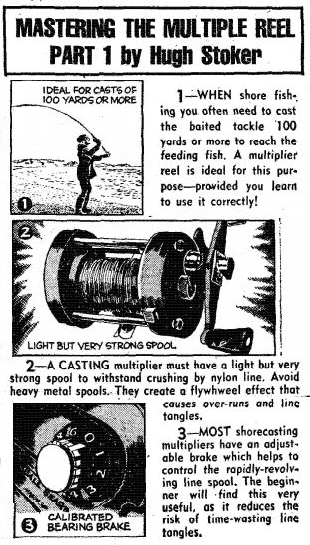
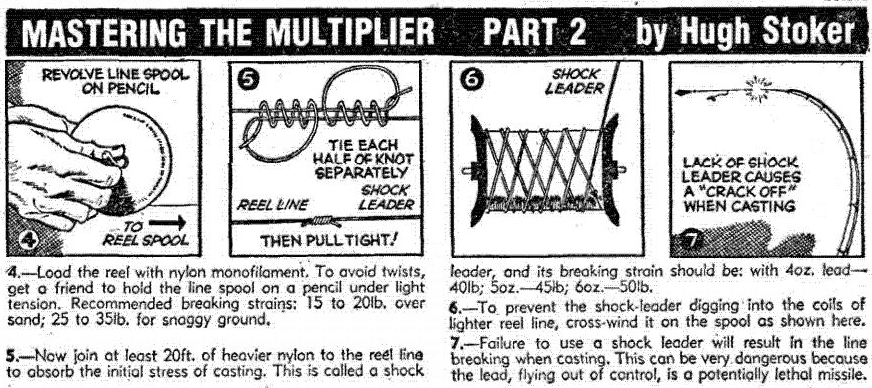
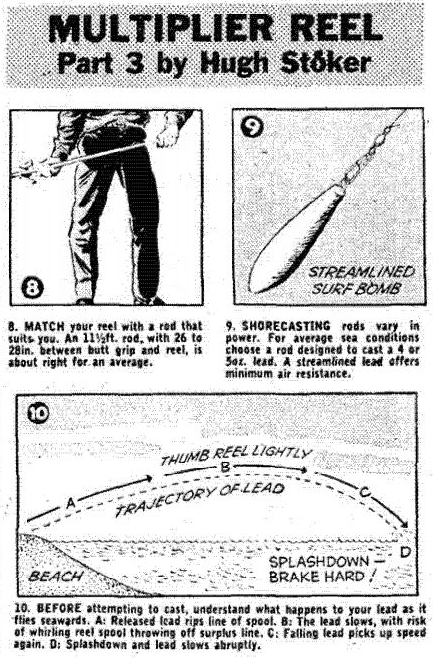
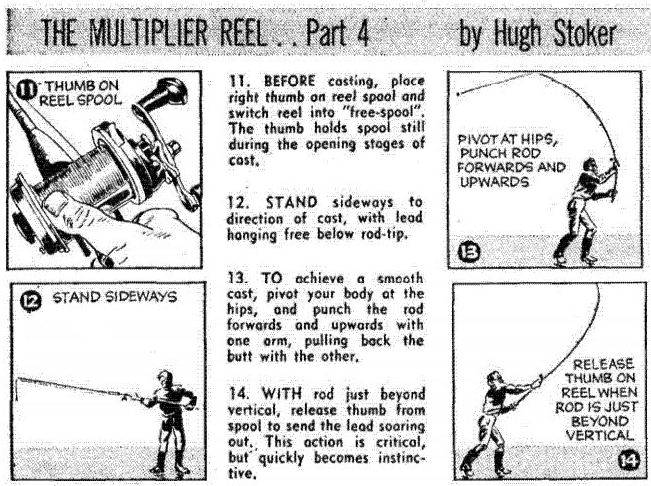
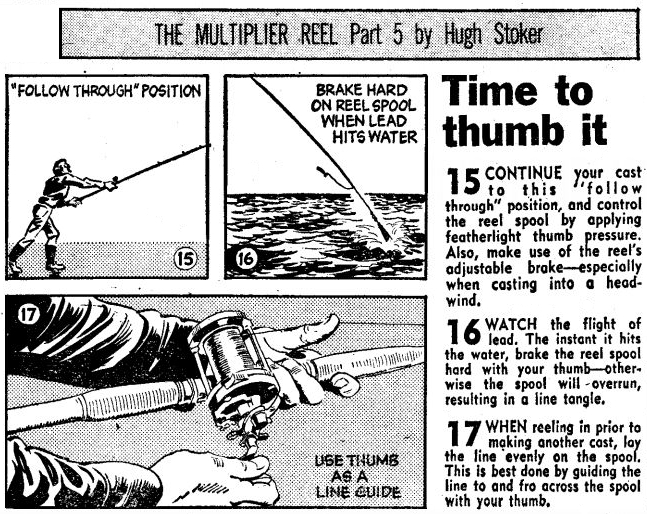
"Cod Fishing" (1987) John Rawle at pages 28 & 29
Beach and Shore Fishing
Casting
I taught myself to cast reasonably well by practising over the field a couple of evenings a week and once you have achieved the sort of distances you are after it is like riding a hike, you don't forget, providing you fish fairly regularly.
The pendulum cast executed correctly, with good gear, will give you over 160 yards without putting much effort into it. Once you have the technique sorted out and start putting some power behind it, you will start getting further. I won't go into pages and pages of how to go about it because there are two very good books on the market by people who are much more qualified than I to write about how to cast: Long Distance Casting by John Holden and Long Range Casting and Fishing Techniques by Paul Kerry both describe and illustrate long distance casting very well. All I will say is it is a lot easier than most people imagine if you put your mind to it and make a determined effort to learn to cast a long way.
I made my mind up a few years ago that I wanted to learn to cast better. I was getting 150 to 160 yards by using a modified pendulum technique. I spent a couple of sessions with my mate Mick Toomer who was into tournament casting at the time and got a few flaws ironed out and then just practised a couple of evenings a week. After 4 or 5, 1½ hour sessions I was averaging 180 yards. Two or 3 sessions later I was getting 190 to 195 and after only ten short practice sessions I started to pass the 200 yard barrier. I got up to about 225 yards fairly consistently after a bit longer, then eased off on the practising. I now nip over the field every now and again for an hour and have a few casts just to keep in touch. What I am saying is, that it is not that difficult providing you are determined and apply yourself to it. You haven't got to cast 200 yards but being able to put a lead over grass 170 to 180 yards means you can put a bait 130 to 140 yards out to sea in reasonable conditions and 80 or 90 yards in rough conditions and this is more than adequate for 99 out of 100 occasions. If you can cast you can always drop short if the fish are in closer. If they are a long way out and you can't cast you will not catch. Good consistent casting is the shore cod angler's biggest attribute, so if you can't then go out and learn, otherwise you are giving yourself a big handicap.

"Hooked on Sea Angling" (2011) Martin & Dave Beer
Beach Casting: After the Storm
Strong winds hitting the south coast after a set of spring tides is the perfect mixture to really stir up the seabed and get fish on the feed - perfect winter fishing conditions.
Storm force winter fishing
The powerful waves will be hitting the coastline scouring out the food stuffs hidden in the substrate creating a soup for cod, dogfish, whiting and the odd big bass. Once the worst of the weather is over and it becomes fishable again, get out there at night. Use big baits to create a strong scent trail, and fish hard. You should use a method called double patting i.e. use two clip on rigs with one baited ready to go so once you have got your gear on the beach you can quickly clip the new rig on and cast out. This allows you to maximize the amount of time you have bait in the water, increasing your chance of catching.
Beach casting - how far?
Try to cast a few baits into the same area, so if you have attracted fish to that spot they won't be disappointed. Then move your cast. Try close in, long range and all areas in between. Spend a bit of time reading the shore line in the daylight to see where all the flotsam is congregating, as this will show you the drift of the beach and where the food is most likely to be.
You need to know where the food, shelter and fish are. Research the species you are fishing for and look for areas where they may gather. Cod hunt closer to the shore at night, bass will hunt for bait fish in really shallow water, wrasse generally hang around close to rocks etc.
If you don't know a fishing mark and you have two beach casters, or even one beach caster and a spinning rod take them both to the fishing mark, cast one as far as you can and plonk one in just 10 foot out into the sea. Then each cast with the long range rod cast less distance each time, and with the close rod cast a bit further each time covering the fishing ground until they meet. When this happens start again but cast to the left for the next set and so on until you have covered the seabed in search of you prize fish.